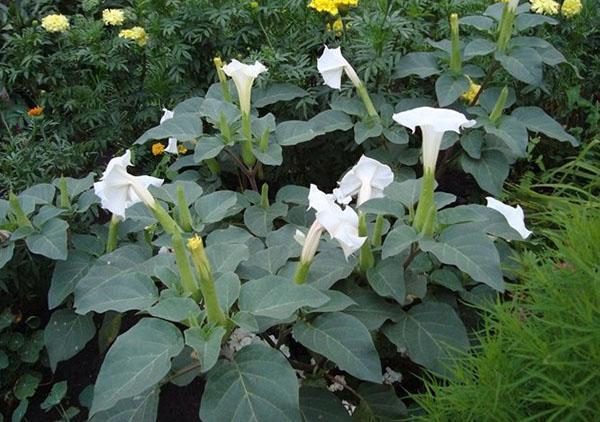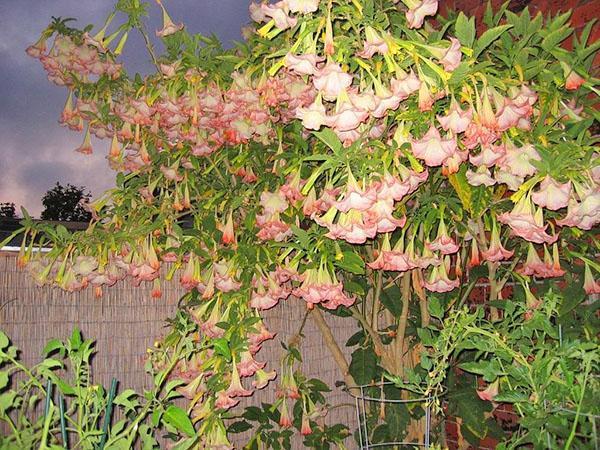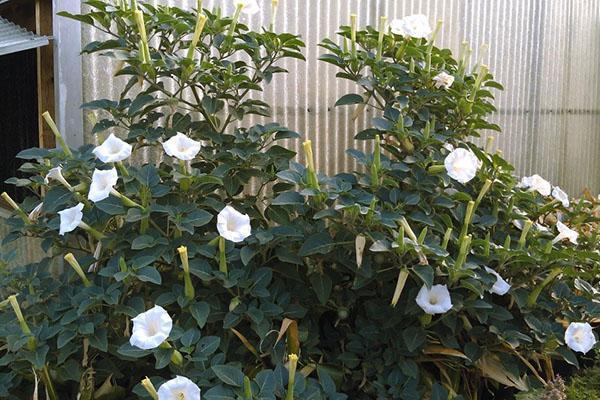A cute flower with mysterious properties - Datura
 As soon as people hear the word - dope, cute flowers in the form of a pipe emerge in their minds, exuding a pleasant aroma. Looking at them from the outside, the fact that the plant is poisonous will hardly come to mind. Despite this, its majestic buds simply fascinate true nature lovers. What if you lift the veil of misunderstanding and look at the flower from the objective side? Probably worth a try.
As soon as people hear the word - dope, cute flowers in the form of a pipe emerge in their minds, exuding a pleasant aroma. Looking at them from the outside, the fact that the plant is poisonous will hardly come to mind. Despite this, its majestic buds simply fascinate true nature lovers. What if you lift the veil of misunderstanding and look at the flower from the objective side? Probably worth a try.
Practice shows that the use or close contact with dope leads to the appearance of vivid hallucinations. That is why shamans and witches used it for their magical rites to deceive people.
Lift the Veil of the Mysterious Flower

 In accordance with various folk legends, the plant is called differently. Here is some of them:
In accordance with various folk legends, the plant is called differently. Here is some of them:
- angelic trumpets;
- henbane;
- devil's grass;
- moonflower;
- crazy grass;
- foolish drunk;
- thymus;
- grass of sorcerers;
- mad potion;
- stupor grass.
Of course, the names are not very nice. In addition, the flower was used in pagan cults to communicate with demons. And the ancient healers treated serious diseases with the plant. Be that as it may, if you follow the safety rules, dope can easily be grown in a summer cottage.
The flower is considered a representative of the Solanaceae genus. Its close relatives are quite pleasant plants. This is everyone's favorite potato, juicy tomatoes or purple eggplant... Basically, datura is a large grass that is distinguished by lodging or erect tubular shoots. They can reach a height of about 120 cm. Outside, the stems are covered with a glossy bark of a dark green or reddish color. When the Datura grass ages, the basal shoots become lignified, acquiring a brownish color.
 From the main trunk branches off, on which successive leaves of large sizes are located (length about 15 cm, width about 10). They are either scalloped or oblong. The outer color is dark green. The back is usually lighter in color. Interestingly, along the vein located in the center of the leaf, a strip of light tone is visible, which gives it a stylish look.
From the main trunk branches off, on which successive leaves of large sizes are located (length about 15 cm, width about 10). They are either scalloped or oblong. The outer color is dark green. The back is usually lighter in color. Interestingly, along the vein located in the center of the leaf, a strip of light tone is visible, which gives it a stylish look.
 If you carefully consider the photo of the dope flower, you will notice that the buds originate in the axils of the leaf plate or at the forks of the shoots. The magnificent tubular inflorescences are composed of five delicate sectors. The depth of the funnel reaches about 15 cm. Some species can boast of bells 25 cm long. Buds appear with the arrival of the first summer days. The last inflorescences are pleasing to the eye in autumn, with the onset of frost. Datura flower can be painted in bright colors:
If you carefully consider the photo of the dope flower, you will notice that the buds originate in the axils of the leaf plate or at the forks of the shoots. The magnificent tubular inflorescences are composed of five delicate sectors. The depth of the funnel reaches about 15 cm. Some species can boast of bells 25 cm long. Buds appear with the arrival of the first summer days. The last inflorescences are pleasing to the eye in autumn, with the onset of frost. Datura flower can be painted in bright colors:
- snow-white;

- Orange;

- yellow;

- bright lilac;

- purple.

The original shape of the bud is in the form of a simple large bell with accrete petals. Some species are distinguished by spiral-shaped complex inflorescences.It has been observed that the Datura plant does not always exude a pleasant aroma. Some varieties practically do not smell, but have an unsurpassed beauty of the buds.
Since the flower belongs to nocturnal plant species, you can admire its buds only after sunset or on cloudy days. When planting in a summer cottage, this fact should be taken into account.
 When the lush flowering passes, fruits are formed on the bushes in the form of large oblong bolls filled with seeds.
When the lush flowering passes, fruits are formed on the bushes in the form of large oblong bolls filled with seeds.  Outside they are covered with a dark green skin with original thorns. The inside of the fruit is divided into 4 sectors.
Outside they are covered with a dark green skin with original thorns. The inside of the fruit is divided into 4 sectors.
 In each of them there are black seeds, round or kidney-shaped. The first boxes appear in July.
In each of them there are black seeds, round or kidney-shaped. The first boxes appear in July.
Enchanting views of the mysterious flower
 Despite the fact that Datura is a poisonous plant, there are about 13 different species of it. But only a few of them are cultivated in summer cottages.
Despite the fact that Datura is a poisonous plant, there are about 13 different species of it. But only a few of them are cultivated in summer cottages.
If you experience symptoms such as reddening of the skin, rapid heartbeat, severe headache, dry mouth and dilated pupils, seek help.
Datura ordinary
 An incredibly resilient plant, often mistaken for a weed, it can grow up to 120 cm in height. Its tubular erect shoots are covered with large leaves with cut edges. When Datura blooms, very few bell-shaped white buds appear on it. But this does not prevent him from exuding an intoxicating aroma.
An incredibly resilient plant, often mistaken for a weed, it can grow up to 120 cm in height. Its tubular erect shoots are covered with large leaves with cut edges. When Datura blooms, very few bell-shaped white buds appear on it. But this does not prevent him from exuding an intoxicating aroma.
 In its natural environment, the flower grows in wastelands, near low bushes, on forest edges and river meadows. As a medicinal plant, it is grown in the Kuban, as well as in the southern regions of Ukraine. The photo shows the common dope in its natural environment.
In its natural environment, the flower grows in wastelands, near low bushes, on forest edges and river meadows. As a medicinal plant, it is grown in the Kuban, as well as in the southern regions of Ukraine. The photo shows the common dope in its natural environment.
The dried leaves of the plant, which are harvested in sunny dry weather, are considered medicinal. Seeds are no less valuable. They are suitable after the fruit pods are fully ripe. It is necessary to store medicinal raw materials in a dry room for no more than 2 years.
Datura Indian
 This species can be found in the flower beds of summer cottages. The plant is a one meter high branched bush. Its large dark green foliage rests on long petioles. The shape of the plate is oblong. Datura Indian buds come in different colors. Much depends on the species. Here is some of them:
This species can be found in the flower beds of summer cottages. The plant is a one meter high branched bush. Its large dark green foliage rests on long petioles. The shape of the plate is oblong. Datura Indian buds come in different colors. Much depends on the species. Here is some of them:
- "Ballerina". Differs in double flowers of purple or yellowish color.

- "Medea". The variety is characterized by snow-white bells approximately 20 cm long.

- Flore Pleno. Terry inflorescences are painted in a pale yellow color.

Datura indian
 This species has very toxic properties. The inhabitants of the American continent used it as a sedative. The shamans of the Indian tribes used in their rituals as a magic drug that causes hallucinations.
This species has very toxic properties. The inhabitants of the American continent used it as a sedative. The shamans of the Indian tribes used in their rituals as a magic drug that causes hallucinations.
The leaves of the Indian dope are ovoid. The color is gray-green. The buds are simple or double-flowered. The maximum length of the inflorescence is about 13 cm.
Simple rules for flower care
 A detailed description of Datura herbs and photos show that the plant does not require much maintenance. It is enough to adhere to the basic rules, and the mysterious flower will stay for a long time at the summer cottage.
A detailed description of Datura herbs and photos show that the plant does not require much maintenance. It is enough to adhere to the basic rules, and the mysterious flower will stay for a long time at the summer cottage.
 If there is an opportunity to grow seedlings on your own, you can safely do this business. The best option is to purchase it ready-made. Datura grass is planted in flower beds in early summer. The distance between the bushes is approximately 100 cm, so that each seedling has enough air, light and moisture.
If there is an opportunity to grow seedlings on your own, you can safely do this business. The best option is to purchase it ready-made. Datura grass is planted in flower beds in early summer. The distance between the bushes is approximately 100 cm, so that each seedling has enough air, light and moisture.
In order not to damage the root of the plant when planting a flower, it is important to keep a small earthen lump on the seedlings.
The soil in the flowerbed should be of a loose character with a neutral or slightly alkaline reaction. If the soil is acidic, you can add a little lime. The most suitable place is a sunny, windless area of the yard.
 Since Datura loves moderate humidity, it needs to be watered regularly.In this case, the water should not stagnate under the bush. The wide leaves of the plant need refreshing, so they should be sprayed periodically.
Since Datura loves moderate humidity, it needs to be watered regularly.In this case, the water should not stagnate under the bush. The wide leaves of the plant need refreshing, so they should be sprayed periodically.
When the budding period comes, it is advisable to feed the dope. Mineral fertilizers are diluted in water, after which they are carefully applied to the soil. To stimulate the flowering of the bush, it is better to water it with hard water. And cut off the lower part of the plant. The procedure is performed in early spring or at the final stage of flowering.
With the onset of cold weather, perennial grass options are completely cut off at the root.
The majestic dope flower, the photo and description of which attracts many fans, tolerates various diseases quite well.  The only problem is gray mold. It occurs if the plants are very densely planted. In rare cases, a spider mite, bugs or weevils can settle on the crown. Pest control is easy with insecticides.
The only problem is gray mold. It occurs if the plants are very densely planted. In rare cases, a spider mite, bugs or weevils can settle on the crown. Pest control is easy with insecticides.
 In mid-latitudes, where severe winters prevail, datura is grown in tubs. Some gardeners in the fall transplant the flower from open ground into deep containers. They are placed in a room where the maximum temperature is maintained at about 13 degrees. In wet weather, they are rarely watered. With the arrival of spring, the plant is taken out to warmer places, creating comfortable conditions for it. Thanks to the fulfillment of such simple rules, it is possible to contemplate the beauty of the "Angelic Trumpets" at your summer cottage throughout the season.
In mid-latitudes, where severe winters prevail, datura is grown in tubs. Some gardeners in the fall transplant the flower from open ground into deep containers. They are placed in a room where the maximum temperature is maintained at about 13 degrees. In wet weather, they are rarely watered. With the arrival of spring, the plant is taken out to warmer places, creating comfortable conditions for it. Thanks to the fulfillment of such simple rules, it is possible to contemplate the beauty of the "Angelic Trumpets" at your summer cottage throughout the season.